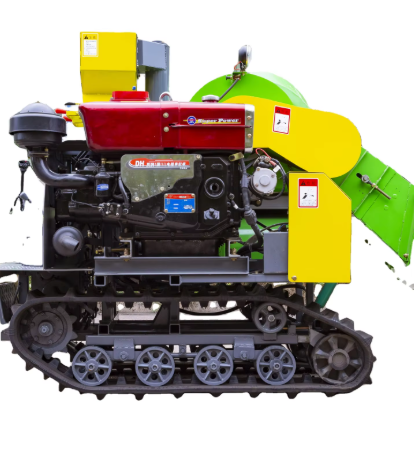Geographic and Climatic Requirements for Small Rice Harvesters
Tropical and Subtropical Growing Regions
Small rice ratoons are particularly adapted to produce under tropical and subtropical conditions of high temperature and regular rainfall. With such weather conditions experienced in countries such as Southeast Asia and in some parts of Africa, multiple harvests within a year are possible which would increase farmers’ yield and income. In this area, where traditional paddy rice farming is very laborious, small size rice combine harvesters are important machines to increase productivity as well as to protect farmers here. These favorable weather conditions result in more harvest cycles throughout the year and make it a highly productive region, with rice production year-round.
Areas with Moderate Slope Gradients
Areas with low slope which falls within a range of 1-10% are suitable for small rice harvesters. These spaces allow better soil drainage, and provide better access by mechanical harvesters when it comes time to harvest the rice. This terrain stabililty is particularly advantageous in hilly terrains where conventional harvesting techniques tend to be labor intensive and difficult. They provide it on a medium / small scale to these regions which will simplify the harvest which results smaller damage for the waiting crops, and higher productivity and lower costs of labor to the farmers.
Regions with Controlled Water Availability
How to Access to controlled water supply by artificial irrigation systems or natural water management practices is a must for efficient small rice harvesters. By maintaining the right levels of moisture for rice cultivation, farmers are able to attain incredible yields in these areas. Knowing the local hydrology and using managed water systems enables to operate resources effectively and shows how productivity can vary with water management. This, in turn, helps the farmers to achieve more with less, and consequently enable the practice of sustainable agriculture and ensure continuity.
Optimal Terrain and Field Characteristics
Small to Medium-Sized Plots (0.5-5 Hectares)
Small rice combine harvesters are made to work in small farming fields of about 0.5–5 ha. This harvester is best suited for small scale farmers with a small land holding because it can be easily maneuvered and used flexibly. While minimizing labor time and maximizing work productivity, the implements assist farmers in increasing economic efficiency and in mechanizing rice harvesting procedure. Couple their compact size with great manoeuvrability on narrow fieldpaths and there are hardly any obstructions you can't cut your way through on your average -and even slightly larger - small-to-medium farm. This allows farmers to maximise their plot size without compromising the efficiency or speed of harvesting.
- Product Recommendation: The Driving-type Small Rice Combine Harvester offers an optimized structure for maneuvering in small plots, ensuring productivity without extensive manual labor.
Muddy or Waterlogged Paddy Fields
Small rice harvesters, able to work in muddy and water saturated environments, can easily work in paddy fields where other harvesting equipment may struggle. Their ability to work under such conditions is based on characteristics such as wide tires or tracks, which help to distribute weight of the machine evenly and minimize soil compaction, protecting crops from damage. Thanks to this design innovation, these harvesters walk softly over tender rice plants to avoid cracking the wet earth beneath, damaging the stalks and losing valuable rice from the panicles. Farmers see better harvesting and the quality of crops is retained, which is important for regions ironically also subject to monsoon rains and heavy flooding.
- Product Recommendation: The Driving-type Small Rice Combine Harvester is equipped with special wheels for paddy fields, ensuring stable performance in waterlogged conditions.
Fragmented Landscapes in Hilly/Mountainous Zones
For the places where farmland is divided and the rice fields are irregular, small rice harvesters are irreplaceable. The wheels are suitable for a variety of terrains and due to their maneuverability can cover over tricky landscapes e.g., hills and mountains. This feature has particular relevance in difficult farming conditions, where conventional techniques are not as effective or labour-intensive. By limiting the requirement of extensive manual works, these machines make the process of harvesting feasible, helping farmers tap the potential of their land, despite it having physical constraints.
- Product Recommendation: The Driving-type Small Rice Combine Harvester is ideally suited for hilly and mountainous terrains, offering flexibility and efficiency in fragmented landscapes.
Regional Case Studies: Successful Deployment Areas
Mekong Delta: Balancing Floodplains and Compact Machinery
The Mekong delta is a model area were rice gets produced in an efficient way using small rice harvesting which is perfectly adjusted to the floodplain agriculture and the conditions there. This is an example of how smaller equipment can work in flood-like conditions to ensure maximum versatility and productivity. By utilizing these technologies, farmers are able to preserve the balance of the ecosystem, but improve yield and operational efficiency. This harmony of man and nature guarantees a sustainable agriculture in the delta.
Southeast Asian Terraced Rice Fields
“Step rice fields” in South-East Asia show that small machines can do good work in tiered plots. In the past, none of these machines have been available and have helped in labour saving and labour reducing, ensure the safety in rice cultivation and sustainable agriculture and protecting the tradition of harvesting. Incorporation of modern agricultural equipment The modern machinery is being incorporated in traditional agricultural methodologies leading to improved farm productivity All rights reserved. This method does not only preserve cultural landscapes but also favours the local agricultural economy.
Italian Hilly Farms with Labor Shortages
Italy’s hilly fields and farms are short of workers, but small rice harvesting machines are being used to keep up yields, showing the flexibility of farming. This case study highlights the significance of technological integration to overcome manpower constraints, and opens windows of opportunities for agricultural productivity in remote locations. Using small-scale machinery these farms remain efficient and mobile whilst offering an alternative and sustainable farming solution which contributes to economic resilience.
Economic and Operational Considerations
Cost-Efficiency for Smallholder Farmers
Application of small rice harvester can save much labor instead of doing by hand. This machine is made for maximum production with minimal manpower or maintenance. Mechanization becomes more accessible due to their low costs of initial purchase and regular operations. Consequently, more smallholder producers can take advantage of this technology to enhance the productivity and efficiency of their farming operations. This transformation not only enhances the efficiency of individual farms, it also increases the agricultural productivity of the whole region.
Government Subsidies in Rice-Dependent Regions
In rice-based areas across the nation, government subsidies to incentivize the adoption of the small rice harvester are vital. These kind of assistance are very important to promote mechanization for smallholder farmers in smallholder community areas which may face financial constraint to make progress. Governments ease the process of acquisition of farming technologies for farmers, through financial aid, to boost food security and economic development in these areas. These incentives contribute to the viability and sustainability of rice production, which in turn is beneficial for both the smaller scale of community and the broader scale of national economies with dependence on stable rice supplies.
Maintenance Challenges in Remote Areas
Although there are certain benefits of small rice harvesters, it's hard to maintain them in the field. Farmers may be unable to keep the machinery working at peak levelsendnotesLimited access to repair shops and resources, for example, can create barriers to the performance of repairs but continue to work with the limited facilities they have. Solving these logistical problems is critical for the successful application of mechanized farming technology in rural areas. By creating models to increase availability of maintenance and repair services, communities can help to guarantee that small rice harvesters continue to provide their desired impact – increasing food production and efficiency throughout the continent – even in remote regions.
FAQ
What are the best climatic conditions for using small rice harvesters?
Small rice harvesters work best in tropical and subtropical regions with warm temperatures and consistent rainfall.
Are small rice harvesters suitable for hilly terrains?
Yes, they are particularly beneficial in areas with moderate slopes, ranging between 1-10%, offering better soil drainage and accessibility for machinery.
How do small rice harvesters handle muddy or waterlogged fields?
They are equipped with features like wide tires or tracks that distribute weight evenly, preventing soil compaction and ensuring optimal yields.
Do small rice harvesters work on fragmented landscapes?
Yes, they are adaptable to navigate complex terrains, including those in hilly and mountainous zones, facilitating efficient harvesting processes.
Why are government subsidies important for adopting small rice harvesters?
Subsidies make mechanization more accessible to smallholder farmers, enhancing food security and economic stability in rice-dependent regions.
What maintenance challenges do small rice harvesters face in remote areas?
Limited access to repair facilities can create operational barriers, so expanding maintenance services is crucial for deployment in rural settings.
Table of Contents
- Geographic and Climatic Requirements for Small Rice Harvesters
- Optimal Terrain and Field Characteristics
- Regional Case Studies: Successful Deployment Areas
- Economic and Operational Considerations
-
FAQ
- What are the best climatic conditions for using small rice harvesters?
- Are small rice harvesters suitable for hilly terrains?
- How do small rice harvesters handle muddy or waterlogged fields?
- Do small rice harvesters work on fragmented landscapes?
- Why are government subsidies important for adopting small rice harvesters?
- What maintenance challenges do small rice harvesters face in remote areas?

